电子科技大学:《中国概况 Survey of China》课程教学资源(课件讲稿)第四章 古代中国人的生活 Ancient Chinese People’s Life
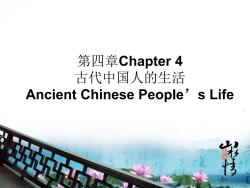
第四章Chapter4 古代中国人的生活 Ancient Chinese People's Life
第四章Chapter 4 古代中国人的生活 Ancient Chinese People’s Life

内容提要 Essentials 1.古代中国人的衣食住行 Basic Necessities of Ancient Chinese 2.古代中国的语言文字 Language and Characters of Ancient China 3.古代中国的书法、绘画、音乐、舞蹈 Chinese Calligraphy,Painting,Music and Dance 4.中国古代的礼仪风俗 Customs and Ceremonies of Ancient Chinese Society
内容提要 Essentials 1. 古代中国人的衣食住行 Basic Necessities of Ancient Chinese 2. 古代中国的语言文字 Language and Characters of Ancient China 3. 古代中国的书法、绘画、音乐、舞蹈 Chinese Calligraphy, Painting, Music and Dance 4. 中国古代的礼仪风俗 Customs and Ceremonies of Ancient Chinese Society
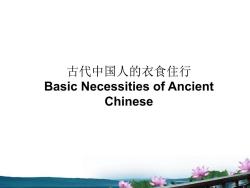
古代中国人的衣食住行 Basic Necessities of Ancient Chinese
古代中国人的衣食住行 Basic Necessities of Ancient Chinese
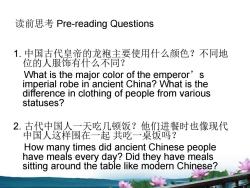
读前思考Pre-reading Questions 1.中国古代皇帝的龙袍主要使用什么颜色?不同地 位的人服饰有什么不同? What is the major color of the emperor's imperial robe in ancient China?What is the difference in clothing of people from various statuses? 2.古代中国人一天吃几顿饭?他们进餐时也像现代 中国人这样围在一起共吃一桌饭吗? How many times did ancient Chinese people have meals every day?Did they have meals sitting around the table like modern Chinese?
读前思考 Pre-reading Questions 1. 中国古代皇帝的龙袍主要使用什么颜色?不同地 位的人服饰有什么不同? What is the major color of the emperor’s imperial robe in ancient China? What is the difference in clothing of people from various statuses? 2. 古代中国人一天吃几顿饭?他们进餐时也像现代 中国人这样围在一起 共吃一桌饭吗? How many times did ancient Chinese people have meals every day? Did they have meals sitting around the table like modern Chinese?
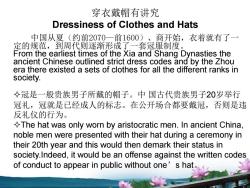
穿衣戴帽有讲究 Dressiness of Clothes and Hats 中国从夏(约前2070一前1600)、商开始,衣着就有了一 定的规范,到周代则逐渐形成了一套冠服制度。 From the earliest times of the Xia and Shang Dynasties the ancient Chinese outlined strict dress codes and by the Zhou era there existed a sets of clothes for all the different ranks in society. ◇冠是一般贵族男子所戴的帽子。中国古代贵族男子20岁举行 冠礼,冠就是已经成人的标志。在公开场合都要戴冠,否则是违 反礼仪的行为。 The hat was only worn by aristocratic men.In ancient China, noble men were presented with their hat during a ceremony in their 20th year and this would then demark their status in society.Indeed,it would be an offense against the written codes of conduct to appear in public without one's hat
穿衣戴帽有讲究 Dressiness of Clothes and Hats 冠是一般贵族男子所戴的帽子。中 国古代贵族男子20岁举行 冠礼,冠就是已经成人的标志。在公开场合都要戴冠,否则是违 反礼仪的行为。 The hat was only worn by aristocratic men. In ancient China, noble men were presented with their hat during a ceremony in their 20th year and this would then demark their status in society.Indeed, it would be an offense against the written codes of conduct to appear in public without one’s hat。 中国从夏(约前2070—前1600)、商开始,衣着就有了一 定的规范,到周代则逐渐形成了一套冠服制度。 From the earliest times of the Xia and Shang Dynasties the ancient Chinese outlined strict dress codes and by the Zhou era there existed a sets of clothes for all the different ranks in society
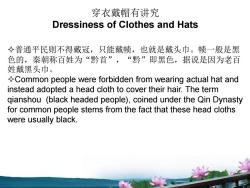
穿衣戴帽有讲究 Dressiness of Clothes and Hats ◇普通平民则不得戴冠,只能戴帻,也就是戴头巾。帻一般是黑 色的,秦朝称百姓为“黔首”,“黔”即黑色,据说是因为老百 姓戴黑头巾。 Common people were forbidden from wearing actual hat and instead adopted a head cloth to cover their hair.The term qianshou (black headed people),coined under the Qin Dynasty for common people stems from the fact that these head cloths were usually black
穿衣戴帽有讲究 Dressiness of Clothes and Hats 普通平民则不得戴冠,只能戴帻,也就是戴头巾。帻一般是黑 色的,秦朝称百姓为“黔首”,“黔”即黑色,据说是因为老百 姓戴黑头巾。 Common people were forbidden from wearing actual hat and instead adopted a head cloth to cover their hair. The term qianshou (black headed people), coined under the Qin Dynasty for common people stems from the fact that these head cloths were usually black
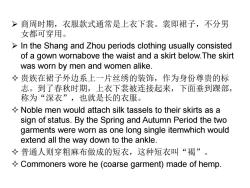
>商周时期,衣服款式通常是上衣下裳。裳即裙子,不分男 女都可穿用。 In the Shang and Zhou periods clothing usually consisted of a gown wornabove the waist and a skirt below.The skirt was worn by men and women alike. ◇贵族在裙子外边系上一片丝绣的装饰,作为身份尊贵的标 志。到了春秋时期,上衣下裳被连接起来,下面垂到踝部, 称为“深衣”,也就是长的衣服。 Noble men would attach silk tassels to their skirts as a sign of status.By the Spring and Autumn Period the two garments were worn as one long single itemwhich would extend all the way down to the ankle. ◇普通人则穿粗麻布做成的短衣,这种短衣叫“褐”。 Commoners wore he(coarse garment)made of hemp
商周时期,衣服款式通常是上衣下裳。裳即裙子,不分男 女都可穿用。 In the Shang and Zhou periods clothing usually consisted of a gown wornabove the waist and a skirt below.The skirt was worn by men and women alike. 贵族在裙子外边系上一片丝绣的装饰,作为身份尊贵的标 志。到了春秋时期,上衣下裳被连接起来,下面垂到踝部, 称为“深衣”,也就是长的衣服。 Noble men would attach silk tassels to their skirts as a sign of status. By the Spring and Autumn Period the two garments were worn as one long single itemwhich would extend all the way down to the ankle. 普通人则穿粗麻布做成的短衣,这种短衣叫“褐”。 Commoners wore he (coarse garment) made of hemp
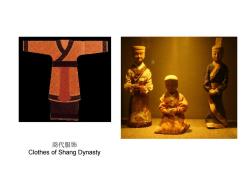
商代服饰 Clothes of Shang Dynasty
商代服饰 Clothes of Shang Dynasty
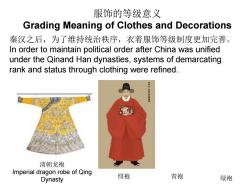
服饰的等级意义 Grading Meaning of Clothes and Decorations 秦汉之后,为了维持统治秩序,衣着服饰等级制度更加完善。 In order to maintain political order after China was unified under the Qinand Han dynasties,systems of demarcating rank and status through clothing were refined. 清朝龙袍 Imperial dragon robe of Qing Dynasty 绯袍 青袍 绿袍
服饰的等级意义 Grading Meaning of Clothes and Decorations 清朝龙袍 Imperial dragon robe of Qing Dynasty 绯袍 青袍 绿袍 秦汉之后,为了维持统治秩序,衣着服饰等级制度更加完善。 In order to maintain political order after China was unified under the Qinand Han dynasties, systems of demarcating rank and status through clothing were refined
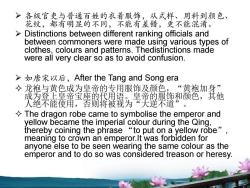
> 各级官吏与普通百姓的衣着服饰,从式样、用料到颜色、 花纹,都有明显的不同,不能有差错,更不能混淆 >Distinctions between different ranking officials and between commoners were made using various types of clothes,colours and patterns.Thedistinctions made were all very clear so as to avoid confusion. >如唐宋以后,After the Tang and Song era ◇龙袍与黄色成为皇帝的专用服饰及颜色,“黄袍加身” 成为登上皇帝宝座的代用语。.皇帝的服饰和颜色,其他 人绝不能使用,否厕将被视为“大逆不道”。 The dragon robe came to symbolise the emperor and yellow became the imperial colour during the Qing, thereby coining the phrase "to put on a yellow robe" meaning to crown an emperor.It was forbidden for anyone else to be seen wearing the same colour as the emperor and to do so was considered treason or heresy
各级官吏与普通百姓的衣着服饰,从式样、用料到颜色、 花纹,都有明显的不同,不能有差错,更不能混淆。 Distinctions between different ranking officials and between commoners were made using various types of clothes, colours and patterns. Thedistinctions made were all very clear so as to avoid confusion. 如唐宋以后,After the Tang and Song era 龙袍与黄色成为皇帝的专用服饰及颜色,“黄袍加身” 成为登上皇帝宝座的代用语。皇帝的服饰和颜色,其他 人绝不能使用,否则将被视为“大逆不道”。 The dragon robe came to symbolise the emperor and yellow became the imperial colour during the Qing, thereby coining the phrase “to put on a yellow robe” , meaning to crown an emperor.It was forbidden for anyone else to be seen wearing the same colour as the emperor and to do so was considered treason or heresy
按次数下载不扣除下载券;
注册用户24小时内重复下载只扣除一次;
顺序:VIP每日次数-->可用次数-->下载券;
- 电子科技大学:《中国概况 Survey of China》课程教学资源(课件讲稿)第三章 中国传统思想 Chinese Traditional Thoughts.pdf
- 电子科技大学:《中国概况 Survey of China》课程教学资源(课件讲稿)第二章 中国历史与社会 The History and Society of China.pdf
- 电子科技大学:《中国概况 Survey of China》课程教学资源(课件讲稿)第一章 地理环境与中国文化 The Geographical Environment and Chinese Culture.pdf
- 电子科技大学:《中国概况 Survey of China》课程教学资源(教学大纲,主讲:李宏亮).pdf
- 运城学院:《中国历史要籍介绍及选读》课程教学资源(电子教案,孔令杰,打印版).pdf
- 对外经济贸易大学:《GER 德国文化 German Culture》课程授课教案(课件讲稿,德语系)Block XIV Kapitel 11 Abschnitt 3 Die Weimarer Republik(II).pdf
- 对外经济贸易大学:《GER 德国文化 German Culture》课程授课教案(课件讲稿,德语系)Block XIV Kapitel XI Die Weimarer Republik(I).pdf
- 对外经济贸易大学:《GER 德国文化 German Culture》课程授课教案(课件讲稿,德语系)Kapitel X Das Wilhelminische Deutschland(1890 - 1914).pdf
- 对外经济贸易大学:《GER 德国文化 German Culture》课程授课教案(课件讲稿,德语系)Block XIII Kapitel IX Das Kaiserreich.pdf
- 对外经济贸易大学:《GER 德国文化 German Culture》课程授课教案(课件讲稿,德语系)Block XII Kapitel VIII Von der Restauration bis zur Reichsgründung.pdf
- 对外经济贸易大学:《GER 德国文化 German Culture》课程授课教案(课件讲稿,德语系)Block XI Kapitel VII Romantik.pdf
- 对外经济贸易大学:《GER 德国文化 German Culture》课程授课教案(课件讲稿,德语系)Block X Kapitel VI Die Klassik.pdf
- 对外经济贸易大学:《GER 德国文化 German Culture》课程授课教案(课件讲稿,德语系)Kapitel V Abschnitt 4 Lesekultur Deutschlands im 18. Jahrhundert.pdf
- 对外经济贸易大学:《GER 德国文化 German Culture》课程授课教案(课件讲稿,德语系)Block VIII Kapitel V Die Aufklärung.pdf
- 对外经济贸易大学:《GER 德国文化 German Culture》课程授课教案(课件讲稿,德语系)Block 7 Kap. IV Abschnitt 5 Aufgeklärter Absolutismus.pdf
- 对外经济贸易大学:《GER 德国文化 German Culture》课程授课教案(课件讲稿,德语系)Block VII Kap. IV Abschnitt 4 und 5 Preussen Preussen.pdf
- 对外经济贸易大学:《GER 德国文化 German Culture》课程授课教案(课件讲稿,德语系)Block VI Kapitel IV Barock.pdf
- 对外经济贸易大学:《GER 德国文化 German Culture》课程授课教案(课件讲稿,德语系)Block V Kapitel III Abschnitt 4 Reformation und ihr Einfluß auf die Deutschen.pdf
- 对外经济贸易大学:《GER 德国文化 German Culture》课程授课教案(课件讲稿,德语系)Block 4 Kapitel III Humanismus und Reformation.pdf
- 对外经济贸易大学:《GER 德国文化 German Culture》课程授课教案(课件讲稿,德语系)Block III Kapitel II Das Mittelalter(II).pdf
- 电子科技大学:《中国概况 Survey of China》课程教学资源(课件讲稿)第五章 中国对世界科学技术的贡献 China’s Contribution to the World’s Science and Technology.pdf
- 电子科技大学:《中国概况 Survey of China》课程教学资源(课件讲稿)第六章 移民与中国社会变迁 Migration and China’s Social Changes.pdf
- 电子科技大学:《中国概况 Survey of China》课程教学资源(课件讲稿)第七章 中西初识与碰撞 Awareness and Collision Between China and the West.pdf
- 电子科技大学:《中国概况 Survey of China》课程教学资源(课件讲稿)第十一章 日益融入国际社会的中国 China Gradually Integrating into the International Community.pdf
- 电子科技大学:《中国概况 Survey of China》课程教学资源(课件讲稿)第八章 近现代中国与西方文明 China in Modern Times and Western Civilization.pdf
- 电子科技大学:《中国概况 Survey of China》课程教学资源(课件讲稿)第十章 当代中国的政治制度及基本国策 Political System and Basic Policies of China in the Present Age.pdf
- 电子科技大学:《中国概况 Survey of China》课程教学资源(课件讲稿)第九章 当代中国人的生活 The Life of Modern Chinese People.pdf
- 中华人民共和国历史(新中国成立——党的十九大).pdf
- 聊城大学:《中国近现代史纲要》课程教学资源(模拟试题,含答案).docx
- 运城学院:《中国近现代史纲要》课程教学资源(教学大纲,打印版).pdf
- 运城学院:《中国近现代史纲要》课程教学资源(习题与试题,打印版,含参考答案).pdf
- 运城学院:《中国近现代史纲要》课程教学资源(电子教案,打印版).pdf
- 中国历史纪年简表(来源:中华人民共和国年鉴).pdf
- 延安大学:《中国共产党历史》精品课程教学资源(PPT课件讲稿)第五章 夺取民主革命的全国胜利.ppt
- 安徽医科大学:《中国近现代史纲要》课程教学资源(教学大纲,54学时).doc
- 安徽医科大学:《中国近现代史纲要》课程教学资源(实践教学计划方案).doc
- 安徽医科大学:《中国近现代史纲要》课程教学资源(习题及阅读书目).doc
- 安徽医科大学:《中国近现代史纲要》课程教学资源(授课教案).doc
- 《中国近代史》课程教学资源(教案讲义,打印版)专题一:军阀、五四、共产党——变局中的新生.pdf
- 《中国近代史》课程教学资源(教案讲义,打印版)专题二:合作、破裂——国民革命的失败.pdf
